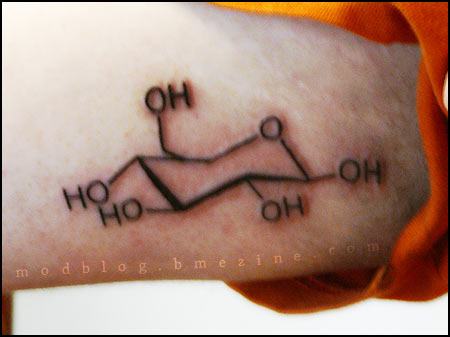If you were wondering, the dreadlock jewelry in this case is 2ga, and serves, I’m told, as a second moustache.
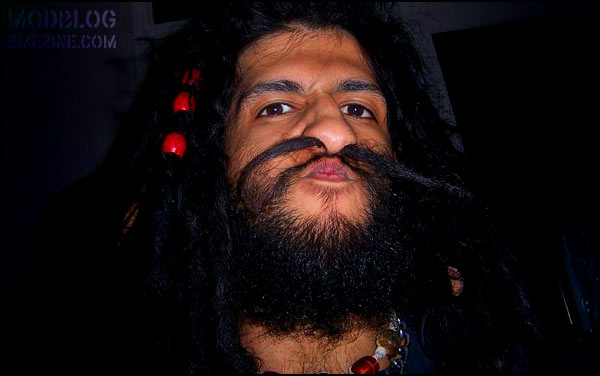
If you were wondering, the dreadlock jewelry in this case is 2ga, and serves, I’m told, as a second moustache.

Der Teufel had this power symbol, USB symbol, and firewire symbol done on his fingers via skin removal by Lord Dunn of Bladesville while he was on tour in Philadelphia (at Infinite).

Remember the cervical piercing I added last month? Well, it’s been followed up with an interview with Ash, the piercer, and it evolved into a really fascinating discussion of post-gender, and is one of my favorite interviews in a long time. Click through to read it and come back to comment!
There aren’t many things that make me miss the forests of Switzerland and Germany where I spent some of my childhood on my great aunt’s land… This photo of Konrad flying at the 3rd Swiss Modmeeting (c/o Visavajara in Freiburg/Nuernberg) at Kanderstet in Switzerland sure does though!
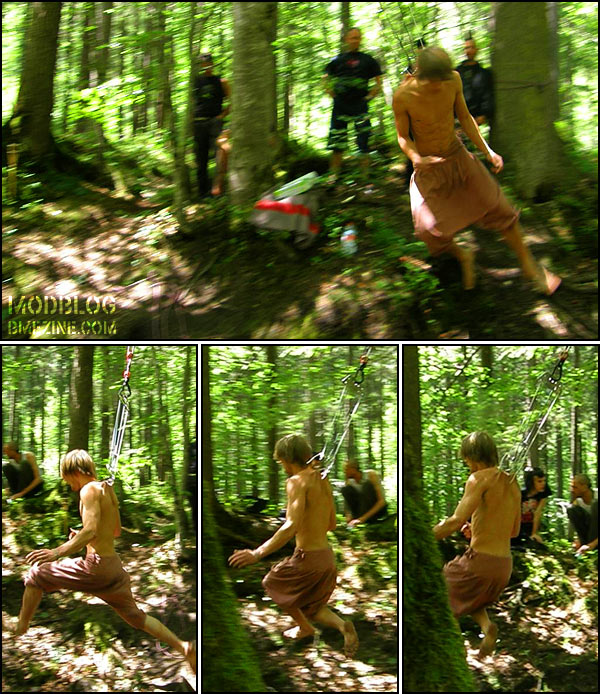
They’ve been featured on BME plenty before, but I thouht I should mention that I finally got around to adding a gallery dedicated to the Kamichaos Twins to BME (thanks to a lot of help from Filipe of NeoArte). You can visit their gallery by clicking through the picture.
Peco, who just did a traditional Hindu-style pulling (click for another picture or visit the galleries on BME) with his cousin Tiago in Campinas, Brasil, writes, “Lord Murugan was there with us, and was amazing!”
My friend Martin Krake who runs europeanglamourgirls.com sends in this shot of Nea and her Christina piercing (you can see more of her at his site).

|
Ashley Crawford: Post-Gender
“Body modification is a personal choice. Primarily, my genitals are the site of erotic pleasure rather than a symbol of my identity or politics. My primary interest in changing my genitals is to enable me to do new and interesting sexual things.”

Those of you who are regular ModBlog readers and BME members may remember that about a month ago I posted — I think for the first time — photos of a cervical piercing. I interviewed Ash Crawford, the piercer who’d done this DIY procedure on themselves, about the piercing, thinking that would be the focus of our conversation, but the interview soon moved into a fascinating conversation about post-gender existence.
A twenty-six year old body modification artist and sex worker that’s spent most of their life in various parts of England, Ash began as a tattoo artist six years ago, later moving into piercing and scarification, and has recently opened their first studio. As a tattoo artist Ash specializes in extensive cover-up work and enjoys combining large scale blackwork with scarification, as an alternative to white-over-black tattooing. A life long interest in body modification first expressed itself doing DIY genital piercings a young teen, and then visible piercings and tattoos after leaving school at age seventeen, aiming for full below-the-neck coverage.
As an adult, Ash became increasingly interested in body modification that blurs the line between male and female — for six years modifying secondary sexual characteristics through steroid use (testosterone) and more recently a bilateral mastectomy. Ash has been making her primary sexual characteristics increasingly ambiguous — not “more male”, but something that seeks a perfect balance between both, with each as prevalent as the other, in order to deny the limiting factors that come with traditional gender roles. As a post-gender human, Ash sees this transition as healthy and liberating, and believes that this view of gender will become increasingly common.
* * *
BME: Let’s get right to it — how would you describe the cervical piercing procedure?
Difficult. It took a lot longer than most piercings. I was doing it all by touch. It took ten minutes or so just to dilate my cervix enough to get the clamp positioned correctly. I used a canula needle, which helped a lot because with these it is possible to shield the point of the needle with the canula until it is positioned correctly and also to insert jewelery in the opposite direction to the way the needle went in. Originally I pierced with a straight barbell and one end sat inside the womb most of the time. I found that when I leaned forwards the ball would “pop” out of the womb, which was distracting and slightly uncomfortable, so I changed the jewelery to a curved barbell which enabled both balls to sit outside the womb at all times and this seemed to solve the problem.
After the procedure there was some cramping and light bleeding from the womb, similar to menstruation, for a couple of days. Due to steroid use it’s been a long time since I menstruated, and I rather enjoyed the novelty of the experience!
While the clamp caused some discomfort and mild pain, the piercing itself was completely painless. I don’t say this lightly. I don’t have a high pain threshold at all. I struggle with the pain aspect of getting my body mods done, and I previously believed that all piercings hurt to some extent.
However, the sensation I felt during the needle insertion was like a deep pressure. It reminded me of getting fucked really hard with something big… Definitely pleasure rather than pain.
BME: How has your cervical piercing healed?
It healed incredibly quickly, and with no action on my part other than abstaining from vaginal intercourse for a couple of weeks. The nice thing about internal piercings is that you just leave them alone and they heal themselves — you don’t even have to worry about the cleanliness of anything that comes in contact with them because nothing will, provided you abstain from penetrative sex for a while.
Sadly I had to lose the piercing when I asked someone to change the jewelery over to a segment ring for me after approximately six weeks. Mainly I wanted someone to do a visual assessment and confirm that the size ring I’d chosen was correct because too large a ring would be holding the cervix open to an uncomfortable degree, and also, to be honest I’ve never put a segment in a segment ring “blind” and I wasn’t confident that I could. This other piercer had trouble and ended up creating a new exit hole with the jewelery which was at approximately 90 degrees to the original. I ended up with a very shallow surface piercing (which I removed) and a lot of swelling which prohibited me fitting jewelery in the original hole.
I am definitely going to re-do this piercing. I was sad to see a couple of comments on ModBlog along the lines of “there is no reason for doing that except to show off”, because I can honestly say that it was one of the most enjoyable piercings I have ever had. I am not ashamed to admit that [im]proving my piercing skills was one of the benefits I gained from this procedure, but it was not the primary motivation. A few comments were also made speculating on any past or future pregnancies of mine. For the record, I have borne one child, who is now seven. I have no plans for more children in the foreseeable future, but if this changes I see no reason why retiring the piercing before attempting to get pregnant would not solve the obvious problems it presents in relation to pregnancy and birth.
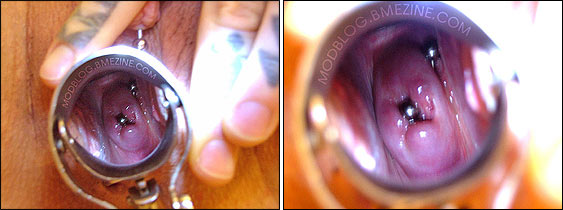
BME: What were the motivations behind the cervical piercing?
Having already gained a lot of pleasure from my g-spot piercings (the first of which I did for myself around six years ago) and been delighted with the fast healing involved, I decided a couple of years ago that I wanted to get my cervix done too. I had been intermittently asking around for a piercer who was experienced with this type of piercing, as originally I thought I would be unable to do it myself. A couple more years’ piercing experience and no luck finding someone who had done the procedure before lead me to decide that I had as good a chance of getting it right as anyone.
I wanted to feel more connected with that part of my body and to be more aware of it during sex and orgasm, and the piercing fulfilled these goals totally. With the piercing in place, I became physically aware of the action of the cervix during orgasm, which I had only had a theoretical knowledge of previously. I did feel a slight “pinching” type of discomfort during and immediately after orgasm, most noticeably in the first week, and to some extent for the entire duration of wearing the jewelery.
It was not severe enough to cause me any worry or distress, and would always pass completely a minute or so after orgasm.
BME: Wow, you have a g-spot piercing as well?
I was probably being incorrect in calling it that. It’s more over the g-spot than through it.
There seems to be more tissue on top of mine than most people’s I have felt. Perhaps it would be more accurate to call it a hymen piercing, but the point of it is to facilitate foolproof location of the g-spot. An average sized fingertip fits snugly between the two balls, and voilà, you’ve got the right place! I’ve had a few, one of which I stretched up to about 8mm until it split. The inside of the split feels fantastic!
BME: I guess it’s sort of like a subincision in that it’s exposing more nerves to direct contact… I assume these atypical piercings have given you much broader insights into your own sexual identity both on a philosophical level and on a physical level?
I’m not so sure about that…
The fact that I thought about these piercings, that I thought they would feel good, and that they did feel good, would seem to reflect a higher level of body-awareness than I have had in the past. In turn, they have changed my body and given me new sensations to be aware of, so in that sense they have increased my awareness even further. They have been positive and perhaps improved my relationship with my body a little, but I wouldn’t claim any deep insights as a result of them.
BME: Your cervical and g-spot piercings were done DIY and by touch — is DIY an important part of the process, or is this something that you could offer others on a commercial level?
With certain clients I would consider doing internal piercings, but there are a number of issues.
The main thing to consider is the anatomy of the individual. My “g-spot” piercing works because I have a larger than average bump there. On some people it would be physically impossible to do the same piercing because there is not real protrusion there to pierce. With a cervix piercing, a client would need to be able to achieve good dilation of both the vagina and cervix and also be able to use their pelvic floor muscles to push and hold the cervix lower down in order to make it more accessible. They would need to demonstrate an understanding of the potential dangers of trying to sustain a pregnancy with this jewelery in place and commit in writing to remove the jewelery before attempting a pregnancy or at the first sign of any unplanned pregnancy. They would also need to understand that placing oneself at risk of STIs with this in place would mean an increased risk of pelvic inflammatory disease, where an infection travels into the womb.
The second issue is my relative lack of experience with these particular piercings. You wouldn’t consider someone to be fully trained and experienced in, say, navel piercing just because they did it on themselves one time! It’s a tough one, because of course you always need to start somewhere. I feel fairly confident that I could get it right a second time, with the right client. Is there any room for being “fairly confident”, as opposed to 100% confident, and still being ethically able to offer something like this to clients? I really don’t know. I guess it would depend on the client and where they were coming from.
One further concern with the cervix piercing is the invasive nature of the procedure. Of course I am used to dealing with genitals as a piercer, but with no other piercing would it be necessary to put my hand inside a client’s vagina. This piercing is a difficult one to do; it’s not quick. When I was doing myself I was in there for maybe ten minutes. A person doesn’t expect to go see a piercer and get digitally penetrated for ten minutes! I’m sure I could decrease the time taken significantly as I gained experience and refined my technique, but still… Of course, this level of contact would be appropriate since the procedure requires it, but I would still have some concerns about how it might make the client feel. It’s important never to touch a client more than they feel comfortable with.
BME: You’ve had more traditional genital piercings as well I assume? How would you compare them?
My first genital piercings were in the hood and labia, and these were for decorative purposes rather than enhancing pleasure, which was satisfying to me at the time. In the last few years I have had somewhat higher expectations of my piercings and have retired the ones that don’t work for me in terms of sensation. I have recently retired my vertical glans piercing after almost two years because that one had always felt slightly uncomfortable, and I figured after all this time that was as good as it was going to heal. I had a horizontal glans piercing before, and that was just terrible — I only kept that a couple of months. I kind of knew that one wasn’t going to work for me, but when I turned up for a vertical glans piercing the piercer was convinced that it would be better horizontal, so I went with that. I guess it works for some people, but for me it got in the way of how I like to be touched so I couldn’t have an orgasm while it was in. I get some sexual pleasure from my fourchette piercing. Both the internal piercings have been less painful and faster healing than any of the others, as well as feeling good, so those are my favourites.
BME: What are the considerations in piercing a testosterone enhanced clitoris? How does the anatomy change from a piercing point of view as it develops?
I’d consider a testosterone enhanced clitoris to be a small penis for the purposes of piercing. Piercing a clitoris is normally a very fiddly procedure, but after a few years on T it’s wildly different. If you are talking about an otherwise unmodified organ then there are some differences that prevent a full range of male piercings being done, but you can still do a lot of them. After a metoidioplasty with urethral relocation the organ is generally indistinguishable from an average penis apart from its size. However, I would be hesitant to do any piercings to a surgically extended extended urethra, as these have a nasty habit of healing shut. I would be concerned that the healing stimulated by the piercing might encourage this to happen, although if the surgery had been performed many years ago I would be less worried than if it was newly healed. If a client came to me with that sort of anatomy I would advise them to seek advice from their surgeon. Piercings like the apadravya and ampallang can be performed with less worry on a metoidioplasty like mine with no urethral relocation. Alternatively, a type of PA or a reverse PA could be done which might give the appearance of exiting at the urethra, especially if stretched, but would actually be exiting the glans from a normal piercing type hole. This could be useful if the client wanted their penis to pass for normal as much as possible in the context of sex or general nudity, but was not worried about using urinals.
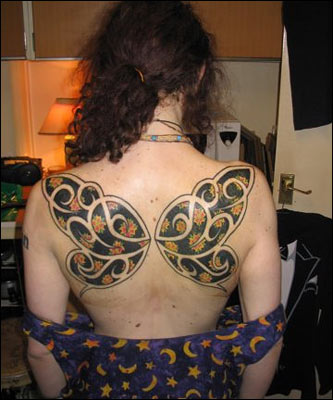
BME: Are there piercings and modifications that are uniquely suited to people who are living in a post-gender body?
People with a post-gender identity or outlook aren’t necessarily perceived to be transgender and may not have any sort of transgender body mods. Even among transgender people there are such a range of bodies and minds, I don’t think it would be possible to say X piercing will suit people with X identity. However, a couple of piercings come to mind as particularly suitable for FtM-spectrum people wanting to make the most of their testosterone-enhanced cock/clit: the triangle, one or more of which can act as the first step toward a metoidioplasty, and the glans piercing which is much more suited to a larger organ than an average sized clitoris. This piercing can provide additional stimulation to a partner during intercourse — very useful considering the size difference between this sort of organ and an average penis — and possibly to the wearer as well, although I wasn’t so impressed with it myself in that respect.
BME: Has the steroid use changed your perception and sensation sexually? That is, does your mind interpret female anatomy in a male way now? Or is that just a gendered misconception about sensation?
It has changed my anatomy, which has in turn changed my sex life. I am a lot more focused on my clitoris now that it is so much larger. It seems like my most important sexual organ now. Sex used to be mostly about penetration for me, but now being penetrated seems like an optional extra, even though I still love it. It’s something I do less frequently, when I want to have a longer sex session and get turned on, but not necessarily come.
I had never had a proper orgasm before I used steroids, and then about a year after I started taking them I learned how to have one. This has had a really major impact on my quality of life in general, not just because I feel so much more relaxed and happy when I have regular orgasms but also because it quickly toned up my pelvic floor muscles and thereby cured the stress incontinence I’d suffered from since my child was born. I don’t know that I would never have learned to orgasm without taking steroids, but I definitely think the anatomy I have now is more easily satisfied than the one I had before. That benefit, which was unexpected, has actually been the greatest one of all.
BME: You mentioned earlier that you self pierced your genitals as a kid. I did the same, as did a lot of people who are now into body modification seriously as adults… Was it just sort of a gut instinct to do so, or was there a context for it?
I’d say it was an instinct. I don’t remember knowing about anyone else having genital piercings so I can’t explain where the idea came from.
Nobody knew, not until I was a bit older anyway. I don’t know how I would have explained it if someone had found out. I suppose I’d have said it was decorative, because in my mind that’s what piercings were always for, and I hadn’t ever heard of another reason. I was mainly aware of ear piercings, which I had always resisted having. It was expected of me as a female to have a piercing in each lobe. One example of this is that on several occasions I received earrings for pierced ears as a birthday present. People just assumed I had it done. I resented what I saw as an attempt to make me modify my body to suit society rather than myself. So, a hood piercing was my very first body modification. It’s hard to know why I chose that area specifically — I think it was just because nobody would see and I wanted it to be my secret for a while. I don’t think it was anything to do with sex at that stage.
BME: Do you think the motivator is more nature than nurture?
People are extremely varied in their motivations. I wouldn’t attribute a reason to serious enthusiasts in general.
In this topic, as in general, I lean more towards nurture in nature/nurture debates. In my case there was no big, obvious thing that lead to my love of body modification, but I am more inclined to think my life experience gave me a number of subtle pushes in that direction than to believe I was born with an inbuilt desire to modify myself. That said, body modification is something humans seem to be turned on to quite easily, in general. There are few, if any, cultures whose people never practice any form of body modification. So maybe the potential to be attracted to body modification is inbuilt in all of us to some extent.
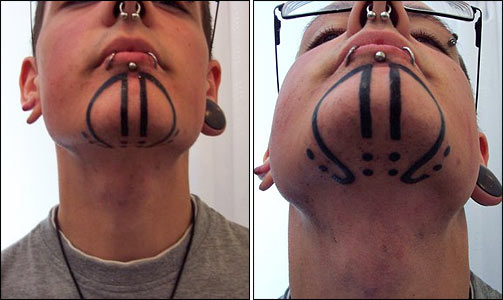
BME: How did you initially come to decide that you wanted to undertake an female-to-male gender transition?
The concept of “a” transition being “one” that I wanted to undertake doesn’t seem very accurate to me. People talk about “a sex change” like it’s one thing, but in fact the term usually describes a collection of different body modifications, and in my opinion each of them deserves to be considered individually.
Using steroids was the first thing I did that would clearly be classed as transgender body modification, although I had been collecting tattoos that some people interpreted as masculine for several years, so perhaps that counts too. There were two main reasons for wanting to take testosterone. I was getting into weight training at the time. I was impatient to feel stronger, and I knew that taking steroids would help me achieve that. That was the main reason. I had done my research and I knew that taking testosterone would make my body a lot more masculine. I was ambivalent at the start — some of the androgenic effects took me a long time to feel at peace with. But at the same time there was an attraction to the idea of looking less feminine because I knew that having such feminine body often made people treat me in a way I didn’t want to be treated. I think that many people have rather low expectations of what girls and women can achieve in certain areas of life, and that sort of attitude has always been very frustrating for me to confront.
BME: In regards to the “masculine” tattoos, do you mean because of their design, or do you mean tattoos being interpreted as masculine in general?
I think it’s just a prejudice that being heavily tattooed isn’t feminine. It was reaching a certain level of coverage that seems to do it rather than the designs themselves. Particularly getting my hands done — so many people interpreted that as a very masculine thing, which seems really bizarre to me. I never thought of my sleeve and hand tattoos as being a transgender or masculine thing when I got them done. I only started to think about them that way later when I was being assessed as a transsexual so I could get a steroid prescription. My extensive tattoos were taken as a clear signal that I was already doing my best to live as a man, as was my short hair and the fact that I only had one lobe piercing at the time. This was an incredibly strange experience, because I’d had that stuff for years and never thought of it as being gendered. The whole thing was so easy for me because my body modifications happened to fit the psychiatrist’s gender stereotype. It’s pathetic really, cause I know a lot of people way more transsexual than I am who are having the opposite problem. At some clinics, trans-women who wear trousers are being told they aren’t committed enough. Most women wear trousers these days for goodness sake!
For a lot of people there is a strong sense that the most important thing a woman can do with her body is to present and modify it to be as attractive as possible to straight men. People don’t frame it like that of course — they try to imply that these efforts simply amount to taking care of ourselves and making ourselves feel good, but a lot of what mainstream society expects women to want from their bodies is extremely narrow-minded and heterosexist, in my opinion. For example, I often hear people debating the acceptability of large tattoos on women. Some people say it is “disgusting” and other people say “no way, women with big tattoos can look really beautiful and feminine…” This can of course be true, but what strikes me about this sort of conversation is that neither side have been able to step outside the paradigm where it is taken for granted that all women want to look feminine so that people who eroticise femininity will find them attractive. To some extent taking steroids was very reactionary. I was so sick of being told via advertising, popular entertainment, and the attitudes of people around me that one of my main concerns in life as a young woman should be to look as pretty and feminine as possible so that guys would fancy me. But then, of course, not to actually fuck all these guys that fancy me, and certainly not to take money for it, because nobody likes a slut or a whore. Riiight… so what is the point of all this looking pretty again? Looking deliberately masculine was very appealing in the sense of doing a big visual “Fuck You!” to a society which shames women who are not young, thin, large-breasted, free from body hair, and all that bullshit.
Before using steroids I’d get cruised almost exclusively by straight men, and that meant that my sexual relationships were always based on the heterosexual butch/femme dynamic. Even with guys that I liked and who seemed to basically respect me as a fellow human, I struggled to create egalitarian relationships under the burden of such a restrictive social script. Having a more masculine body was a way to opt out of that dynamic and to attract more sexual partners who would be open to other ways of relating.
To some extent, I had internalized a lot of the messages I’d been given about female masculinity being unacceptable. Even though I felt oppressed by those messages and was reacting against them by deliberately making myself masculine, there were often moments when I felt disgusted by the changes. I suppose what made me stick with it was that my androgenised body really worked for me in terms of changing the way people viewed and responded to me in social, romantic, sexual, and professional contexts — basically, in every area of life. While there were some changes that were negative, in general the changes were positive.
My main memory of being feminine was how patronizing people can be. For example, when I had not used testosterone for long and was still quite feminine, clients would often treat it as a joke or at least some sort of a big deal that there was a female tattoo artist in the studio. I remember one guy asking, “how did you learn to be a tattooist — did your boyfriend teach you?” I came back with “how did you learn to be so patronizing — did your boyfriend teach you?”… which I still look back on and feel happy about, because you know how often the witty responses don’t usually come to mind until its too late!
In a sexual context too, everything changed for the better. Suddenly I was getting cruised mainly by bisexuals, and they didn’t have this dumb way of approaching sex like too many heterosexual men I’d met. That idea that the woman may be reluctant and the guy’s job is to persuade her to fuck anyway by introducing the idea gradually or just by being persistent… How disrespectful! Of course I’m not saying that all straight people are like this or that all queer people are great at respecting each other’s boundaries, but in my own life I’ve noticed an obvious trend there. These days, I get cruised by bisexuals of all genders, dykes, and the occasional gay man, and it’s very rare for me to encounter someone who doesn’t accept that yes means yes, no means no, maybe means we should talk about what we both want and see if it matches up, and most importantly that having casual sex means we are both sluts and that being a slut is no bad thing anyway. These aren’t difficult concepts to grasp — why can’t more straight boys understand them?
I have now learned to accept, and even perhaps to love, all the changes to my body. To some extent it just took time to adjust, but it has also helped to have had so much love, lust, and general positive energy directed toward my body and mind by all my friends and allies over the last few years.
I was offered a bilateral mastectomy on the NHS [National Health Service] about a year after I started using testosterone, which I accepted. This is not a modification I would have pursued for its own sake. The main motivating factor was the knowledge that if I went along with the standard transsexual script — that I wanted to look as male as possible — then I’d get my steroids free for the foreseeable future. The other thing is that there is a lot of breast cancer in my family, so I was always half expecting to loose my breasts eventually regardless of any transgender issue. It was a more a case of “do I have this done now or in middle age?” than “do I have this done at all?” Basically I feel pretty neutral about this modification. I didn’t hate my breasts but I don’t miss them either.
I guess the interest in becoming more genitally intersex just stemmed from the amount of clitoral growth I got from using testosterone over the years. When you’ve grown something that gets almost big and hard enough to fuck with, then I think most people who were comfortable with that would become fascinated by the possibility of making a few changes so that they could choose to take the insertive role in sexual intercourse more easily.
BME: “Post-gender” as a concept, versus a more delineated switch of gender role is very interesting to me… how common is that concept?
I’ve noticed that a major genderqueer/post-gender scene here in the UK seems to be very much based around the fringes of the sex-positive dyke and bisexual scenes and there seem to be a large number of people there on the FtM spectrum, probably because a lot of those people used to identify as butch dykes. However, there are some very vocal post-gender spokespersons on the MtF spectrum too. Kate Bornstein is a big name among those of us who like our gender theory good and radical. Also, genderqueer people on the MtF spectrum have been hanging around the gay male scene for years. Maybe those communities have developed a slightly different language and set of priorities around transgender issues, but interesting things are still going on there.
Post-gender is absolutely not a transitional point between genders. That phrase implies that there are two proper genders to travel between and post-gender is somewhere you stop off on the way. The gas station of genders, if you will. Not a proper sort of place in itself. I see post-gender as a useful viewpoint for looking at society in general rather than a sort of half-way place between genders at which individuals can choose to reside.
For me personally, the basis of a post-gender identity is being aware that nothing is essentially male or female other than the reproductive organs, and that even these can occasionally be other than male or female; for example, they can be intersex. Anything else that appears to be gendered just seems that way because of stereotype and social convention.
Most aspects of behavior and appearance can be a gender signal to some extent. For example, for an androgynous person, having long or short hair can make the difference between being read as male or female. Yet hair length is weakly gendered, and will only be noticed as a gender signal in the absence of stronger ones. If stronger signals are there, a man can have long hair or a woman short hair without being considered transgender. Long hair may be traditionally associated with women but it isn’t an essential part of being a woman. It’s optional.
OK, so let’s take a more challenging example: Breasts. Most people think these are fundamentally female.. but are they really? If so, how did the concepts of “man boobs” and “bitch tits” ever come to exist? Why does the body modification called “male chest reduction” exist? It’s not just FtMs having this done! Of course there is a major trend towards men having less fat on their chests than women, but what we have come to accept as normal and acceptable does not include all of the body types that exist naturally. This is why increasing numbers of women are having breast implants and increasing numbers of men are having liposuction on their chest.
BME: I’ve actually had this procedure done because I was teased most of my life about it and wanted to move to a more stereotypically male body that I felt more comfortable in.
I’m not knocking these types of modification, I’m just pointing out that the physical characteristic of having a substantial amount of fat on the chest occurs naturally in some men and does not occur naturally in every single woman. So, having breasts or not is a gender stereotype rather than an essential part of gender. A man could have a quite lot of fat on his chest, or a woman very little, and neither would be considered transgender if this was the only way they deviated from their gender stereotype. They might be considered unattractive and made to feel bad about their chests, but there wouldn’t be a real sense that they were something other than male or female.
Post-gender is about realizing that gender performance is elaborate and complex, but when you strip it down to its component parts, there’s nothing really there. Almost nothing about a person is truly gendered, although most things can be, in context. Post-gender means choosing not to “do” gender. People will still see gender in you because we are all raised to see gender in everyone (and you can choose to play with those perceptions) but as a post-gender person you have that awareness that gender is not a real thing. A haircut is just a haircut and a chest is just a chest. You bring that awareness to the way you think of yourself and interact with others.
BME: Do you think this awareness is possible for everyone? Or is it possible that having this awareness is a physical impossibility for a majority of people?
I don’t see why it would be a physical impossibility, but everyone has different views about the world and this is not currently a popular one. That’s OK. People are different and that’s what keeps life interesting. As long as people can refrain from being horrible to each other, it doesn’t matter if they have different opinions.
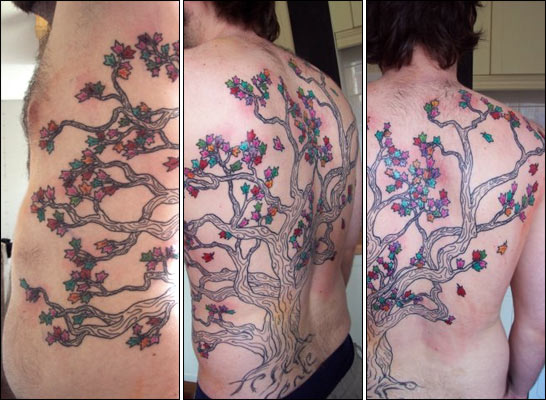
BME: What insights does it give you about the world to be able to have experienced life from multiple hormonal foundations?
While a change in hormone levels had all sorts of temporary effects, I got used to my new base-line hormone levels and now I experience a full range of moods and have the same personality I’ve always had. Well, as much as anyone has the same personalty after gaining several years’ life experience. I think when people say things like “men are more sexual and more aggressive than women, and this is because of their hormone levels” they are hugely overestimating the role of biology in the behavioral traits of men compared to women. I think these things have far more to do with socialization than biology.
I’m not saying that hormones have no effect on the mind-body. Clearly they have many effects. However, these are frequently blown out of proportion by people who want to justify their differing expectations of men and women in work, social, or sexual contexts. I have always believed these sorts of arguments to be spurious and prejudiced. My experiences of steroid use have given greater foundation to this belief.
BME: I’ve heard these arguments often most strongly from inside the transgender community as well — is there a philosophical rift between transgender and post-gender?
The transgender and transsexual communities are very diverse, and there is a lot of infighting over issues like this. I can understand why. There are a lot of transsexual people who only believe in two genders, and that they got the wrong sort of body to go with their inner gender. It’s threatening to hear someone say that inner gender doesn’t exist — it probably feels like I am undermining the importance of their transition. I’m not trying to do that. I respect their reality, even though it’s not mine. Someone tells me they experience God, I say cool, I don’t, but hey, maybe you’re right. Someone tells me they experience gender identity, I say pretty much the same. I’m not arrogant enough to believe that my reality is the only one or even the most valid one out there, but it works for me. When someone’s beliefs mean that they feel justified in doing something that harms me, then I guess that’s the time to start arguing about the truth. Other people’s transition or gender identity doesn’t do that. It’s only if they start telling me what to do with my gender and my body that it becomes an issue. Les Feinberg made a very wise statement on this subject: “My right to be me is tied with a thousand threads to your right to be you.” The same society that gives transsexuals a hard time when they don’t pass is responsible for giving me a hard time when I don’t look unambiguously male or female, and for the same reasons.
An interesting thing to consider is that what seems like a massive difference in identity may be simply a matter of semantics. For example, a few months ago I was chatting to someone who wanted to start taking testosterone because they felt like they might be a man in a woman’s body. I asked them to tell me more about that experience in detail. When we broke it down, we realized our motivations for wanting to take testosterone were virtually identical. The person experienced a huge dissatisfaction with the way they were treated because they had a female body and preferred the idea of being treated like men usually are. In addition, they wanted to have a stronger, stockier body because they thought it would feel more comfortable to be in. I can relate to all that; it was just the “man in a woman’s body” label I don’t understand and wouldn’t want attached to me. It’s helpful when people can put aside their differing labels for a while and concentrate on what they have in common.
BME: With testerone being the first major undertaking you took, to what extent did this shape the further ones? I remember being struck in the “You Don’t Know Dick” documentary by people who’d started taking testosterone commenting on how much it affected their view of the world — do you think the testosterone changed your course (or accelerated it) in any way?
Definitely. It started with taking testosterone and this lead to the other modifications.
I definitely wouldn’t have agreed to have the bilateral mastectomy if I hadn’t enjoyed taking testosterone so much. When I got diagnosed as transsexual and my name went down on the waiting list, I told myself I’d just take the steroids until I got a date for the operation and then say I’d changed my mind. I didn’t want it done. However, I had such a positive experience with the testosterone that when the time came I decided it was worth losing my breasts to keep getting the prescription. I didn’t realize at the time how easy it was to just buy testosterone at gyms, on the gay scene, and even online. Perhaps I’d have made a different choice if I knew, but I am actually really happy with the way it worked out. After the operation my chest felt weird — I could feel bone where there was flesh before and I hated it. I’m not bony anywhere else! I compensated for the loss of soft tissue by doing loads of pec work in the gym. After a couple of years I had pretty much the same measurements as before, only it was muscle rather than fat. It’s hard work to maintain (in fact I haven’t maintained it of late and need to get my lass back in the gym!) but I love the muscle more than I’d loved the breasts. Having something you’ve worked hard for it always more satisfying, isn’t it?
The testosterone lead to me becoming more intersex and I’ve started doing a metoidioplasty to enhance that effect. That’s not something I could have done, or would even have thought of, without having the testosterone first. My clit is trying its best to become a dick under the influence of the testosterone. If your dick was attached to you all along its length you can probably imagine how frustrating that might be sexually. It seemed obvious that if I cut the tissue away I’d have better sexual function. Only after I had done it did I read that doctors offer a similar modification to FtM transsexuals. Surprisingly, though, it actually seems smaller most of the time now I’ve done that. Before, it was stretched out full length and held in place, but now it shrivels down to nothing when its not erect.
BME: Finally, and I worry that this question is almost offensive in nature, but since you say you never experienced an orgasm until you started taking male steroids, do you think your life and view of gender would be different if orgasm had come to you easily “as a woman”?
I think the biggest difference would probably be that I wouldn’t appreciate it as much. How many able-bodied people in their late twenties think “wow, it’s just so wonderful to be able to do this” when they jerk off? Not so many, I bet! In all aspects of life, it’s easy to take the little pleasures for granted when they have always been there.
I don’t see it as being a major issue in my life. I like sex about as much as I did before, and I still enjoy lots of sex that doesn’t include orgasm. Orgasm is not the most interesting or rewarding thing about sex, in my opinion. I can’t see how being orgasmic at an earlier age would have affected my non-sexual life or my view of gender very much, if at all. Who knows, though… Sometimes in life the little things affect the big things in ways you could never have predicted.
BME: Thank you, Ash, for one of the most enlightening conversations I’ve had in a long time!
You can also visit Ash at the following websites:
Thanks again to Ash for a wonderful and eye-opening conversation.

Shannon Larratt
BME.com
I’m sure that Nenita is perfectly able to consent to a piercing and I don’t really have a problem with it, but pictures of little kids in pain always upset me… This was done by Martin at Tattoos by Tito in Bahia Blanca, Argentina.
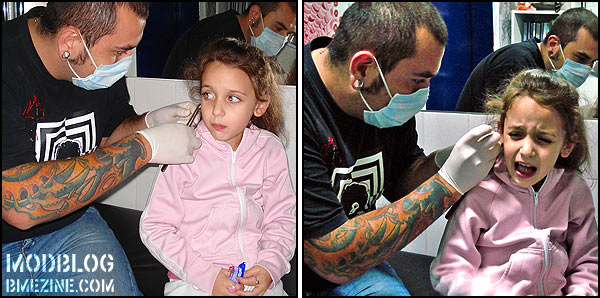
Last year, at age 23 (what is it with 23?), Andrew found out that he had Type 2 Diabetes… He had a really hard time dealing with it, but writes that getting this glucose molecule tattoo helped a lot. It was done by Kevin at Crescent Moon in Moncton.
